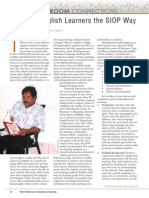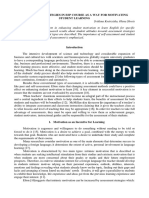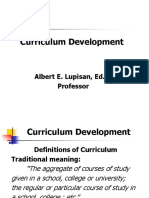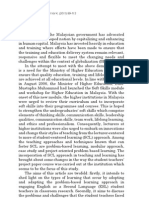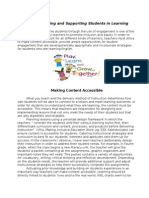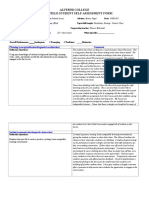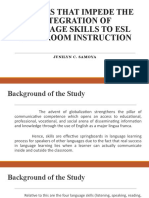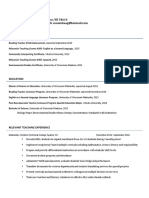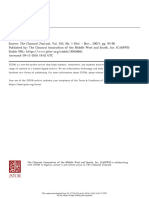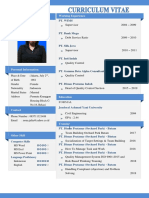Reading Artifact Reflectionstandard7planning
Reading Artifact Reflectionstandard7planning
Uploaded by
api-292471312Copyright:
Available Formats
Reading Artifact Reflectionstandard7planning
Reading Artifact Reflectionstandard7planning
Uploaded by
api-292471312Original Title
Copyright
Available Formats
Share this document
Did you find this document useful?
Is this content inappropriate?
Copyright:
Available Formats
Reading Artifact Reflectionstandard7planning
Reading Artifact Reflectionstandard7planning
Uploaded by
api-292471312Copyright:
Available Formats
Reading Artifact Reflection- Standard 7
Artifact Title: Instructional Planning
Date Experienced Completed: Spring 2014
Artifact Description
This artifact consists of four documents: 1) ELL Language Investigation
Lesson Plan, 2) Across-the-Curriculum Mini-Unit: SIOP Science, Reading and ELL
Lesson Plans, 3) a research paper and power point presentation entitled Final
Research Project: Best Practices and Models for ELL Instruction, and 4) Thematic
Unit: Literature and Science, a week long lesson plan completed for the Foundations
in Literacy PreK-12 course. The lesson plans demonstrate my ability to plan
systematic instruction for various developmental stages, based upon best-practices
and models, as well as knowledge of subject matter and students. The third
document especially demonstrates my knowledge of specific instructional practices
correlated with positive student outcomes.
Wisconsin Standard Alignment
These documents best align with Standard 7 that states:
“The teacher organizes and plans systematic instruction based upon knowledge
of subject matter, pupils, the community and curriculum goals.”
In the Final Research Project, I describe the components of research-based
best practices in ELL instruction, and recommend an instructional model for
inclusion of all of these best practices. The cognate lesson plan provides evidence of
my ability to organize and plan for systematic and explicit instruction that also
supports explorative learning through “word sort” activities. The unit lesson plans
clearly demonstrate my ability to select instructional goals and to incorporate a
variety of resources into coherent instruction. The unit lesson plans and reflections
demonstrate my genuine care and intent to engage families in the educational
process, as well as assuming a leadership role in school and district projects.
These documents align with UW-Platteville School of Education KSDs: 1c, 1d,
1e; 3b, 3d, 3e; and 4c, 4d.
What I learned about teaching and learning from this experience:
English language students are more likely to learn words when they are
explicitly and systematically taught, embedded in meaningful contexts, and when
students are provided with many and varied opportunities for their repetition and
use. Effective teachers provide ELLs many opportunities to practice the target skills
in a low-anxiety setting with assistance from the teacher, in small groups, such as
peer tutoring and cooperative learning groups, and independently. Explicit
instruction and building background knowledge are important best practices in
literacy instruction; however, students also need to be productively engaged in a
learning community of peers of varying English proficiency levels who can model
appropriate English structures and word use.
Explicit and systematic instruction is especially important for ELLs because
clear, specific and predictable instruction provides a “safe” (lower-risk) learning
environment. One of the most interesting research studies I reviewed (Hawkins,
2004) reported that ELLs use their knowledge of classroom procedures and
expectation to leverage social inclusion amongst their classmates. Social inclusion
lowers the affective filter and increases the students’ motivation to learn. “(ELLs)
learned strategies that make (them) look like (they) were participating in the same
ways as other students before actually having the English skills to fully do so. As a
result (ELLs) were included in social interactions, which provided (them) an
opportunity to negotiate new language and understanding” (Hawkins, 2004, p.16).
The students in Hawkins’s observations relied on clear, specific, and predictable
routines that enabled them to mimic, repeat and practice language in context.
What I learned about myself as a prospective Reading teacher as a result of
this experience/artifact:
I think that in an attempt to make classrooms student-centered and
exploratory, the best practice of explicit instruction has too often been neglected. I
am concerned that teachers assume that students know what to do, or students are
too often left to figure things out on their own. What students-- especially ELL
students-- need is explicit and systematic instruction. Explicit instruction is teacher-
led instruction that clearly models how to complete a task step-by-step. A teacher
begins explicit instruction by stating learning goals, demonstrating how to complete
a task, providing feedback during guided and independent practice, and assessing
student understanding and ability to complete the task.
One of the most promising models for ELL reading instruction that I have
encountered during my research is the Sheltered Instruction Observation Protocol
(SIOP). Teachers use the SIOP Model as a lesson plan checklist to provide a
systematic approach for making content accessible to ELLs and for consistently
focusing on academic language. The three main sections of the SIOP are
preparation, instruction and assessment. Preparation involves identifying language
and content objectives, and planning for meaningful activities with the use of
supplementary materials. Instruction involves using comprehensible input to build
students’ background knowledge and to teach skills strategies. Review and
assessment includes providing feedback to the students on content and language
objective mastery. Since I learned about the SIOP model, I have used it for lesson
planning for all of my classes and subjects since it combines all of the common-sense
“good-teaching” practices and places a special emphasis on language development,
which is especially important for ELLs.
You might also like
- Gregg Transcription, Diamond Jubilee Series-2 PDFDocument520 pagesGregg Transcription, Diamond Jubilee Series-2 PDFdsmc95% (20)
- Efl Course DesignDocument2 pagesEfl Course DesignAnonymous RZ6a0pNo ratings yet
- Survey of English and American Literature 1Document3 pagesSurvey of English and American Literature 1Rod Tempra86% (7)
- Syllabus DesignDocument23 pagesSyllabus Designhanna safiraNo ratings yet
- Birds' Eye View of ELL ProgrammingDocument4 pagesBirds' Eye View of ELL ProgrammingJohn WolfeNo ratings yet
- Rumūz Al-Awqāf (Stop Signs)Document1 pageRumūz Al-Awqāf (Stop Signs)Ibrahim MujahidNo ratings yet
- Article Teaching English Learners The Siop WayDocument4 pagesArticle Teaching English Learners The Siop Waysublimity2010No ratings yet
- Lesson 3Document5 pagesLesson 3Rhea Mae GastadorNo ratings yet
- Inquiry Based LearningDocument4 pagesInquiry Based LearningBrigitta AdnyanaNo ratings yet
- Modes of Integrative Teaching 2Document6 pagesModes of Integrative Teaching 2Real Mae PeñaNo ratings yet
- Class NotesDocument13 pagesClass Notesemma.b26No ratings yet
- rdg323 Final Course ReflectionDocument7 pagesrdg323 Final Course Reflectionapi-488068102No ratings yet
- Teacher LearningDocument71 pagesTeacher Learningespanol.a.tu.ritmoNo ratings yet
- Evidence Based ClaimsDocument30 pagesEvidence Based ClaimsScott Parrish100% (2)
- Crosscurricular Teaching and Learning EnglishDocument8 pagesCrosscurricular Teaching and Learning EnglishLug TherapieNo ratings yet
- HBEL 3203 Teaching of Grammar: Fakulti Pendidikan Dan BahasaDocument22 pagesHBEL 3203 Teaching of Grammar: Fakulti Pendidikan Dan BahasaMilly Hafizah Mohd KanafiaNo ratings yet
- EFL Teachers Attitudes and PerspectiveDocument6 pagesEFL Teachers Attitudes and PerspectiveSouad BenguegaNo ratings yet
- The Integrative Strategies of TeachingDocument22 pagesThe Integrative Strategies of TeachingDan Lhery Susano GregoriousNo ratings yet
- Topic 25. EFLDocument13 pagesTopic 25. EFLAntonioNo ratings yet
- The Learner-Centered ApproachDocument6 pagesThe Learner-Centered ApproachPaul James Cabidog BaltarNo ratings yet
- Reading Artifact Reflectionenvironment5Document4 pagesReading Artifact Reflectionenvironment5api-292471312No ratings yet
- MethodsDocument34 pagesMethodsAzat ArnaNo ratings yet
- An Experimental Study of Learner Autonomy in Language LearningDocument18 pagesAn Experimental Study of Learner Autonomy in Language LearningMaria Victoria PadroNo ratings yet
- Types of MotionDocument20 pagesTypes of MotionMelanie Panza ManibaleNo ratings yet
- Assessment Strategies in Esp Course As A Way For Motivating Student LearningDocument8 pagesAssessment Strategies in Esp Course As A Way For Motivating Student LearningEnal EmqisNo ratings yet
- Curriculum Development: Albert E. Lupisan, Ed.D. ProfessorDocument26 pagesCurriculum Development: Albert E. Lupisan, Ed.D. Professorvasil jiang100% (1)
- St103 Group 2 FinalDocument48 pagesSt103 Group 2 FinalJudyl Arciga CamoNo ratings yet
- Justol May Princess, Galve Maria AngelaDocument6 pagesJustol May Princess, Galve Maria AngelaMay Princess JustolNo ratings yet
- Essay 1Document12 pagesEssay 1Laiba TufailNo ratings yet
- ED 3 Material 4Document14 pagesED 3 Material 4Ajeia IsmaelNo ratings yet
- PhonicsDocument33 pagesPhonicsranju1978No ratings yet
- Ef0c PDFDocument8 pagesEf0c PDFErnalyn UntingNo ratings yet
- Content Based ResumenDocument6 pagesContent Based ResumenGaby GonzalezNo ratings yet
- Files-Notes-Teacher & CurriculumDocument7 pagesFiles-Notes-Teacher & CurriculumFerliza Cudiamat PacionNo ratings yet
- English Language Journal Vol 4, (2011) 99-113 ISSN 1823 6820Document13 pagesEnglish Language Journal Vol 4, (2011) 99-113 ISSN 1823 6820Mohd Zahren ZakariaNo ratings yet
- Standard 4 - Instructional StrategiesDocument2 pagesStandard 4 - Instructional Strategiesapi-220430004No ratings yet
- Seminar in Tefl Grup 10Document10 pagesSeminar in Tefl Grup 10LULU ALPINA DEWI UINJKTNo ratings yet
- English Conversation SkillsDocument16 pagesEnglish Conversation SkillsglobevietnamNo ratings yet
- Essay 2Document8 pagesEssay 2api-285027832No ratings yet
- A Closer Look at The Five Essential Components of Effective Reading Instruction: A Review of Scientifically Based Reading Research For TeachersDocument45 pagesA Closer Look at The Five Essential Components of Effective Reading Instruction: A Review of Scientifically Based Reading Research For TeachersBhushanNikamNo ratings yet
- CF Sites Default Files Downloads Selecting Methods and MaterialsDocument35 pagesCF Sites Default Files Downloads Selecting Methods and MaterialschiewjungNo ratings yet
- Module 1 - Curriculum DevelopmentDocument10 pagesModule 1 - Curriculum DevelopmentRicky ApostolNo ratings yet
- Text 5 - Cross-Curricular Teaching and Learning - Practice MatrixDocument2 pagesText 5 - Cross-Curricular Teaching and Learning - Practice MatrixMaja BušatovićNo ratings yet
- Research Article Re Ective Teaching in English Language Classrooms: Perception and Practice of English Language Instructors at Wachemo UniversityDocument14 pagesResearch Article Re Ective Teaching in English Language Classrooms: Perception and Practice of English Language Instructors at Wachemo Universityjamalmercy21No ratings yet
- Professional Semester III Growth Plan - Amber MackintoshDocument7 pagesProfessional Semester III Growth Plan - Amber Mackintoshapi-266794577No ratings yet
- Nunan (1994) Enhancing The Role of The Learner Within The Learning ProcessDocument8 pagesNunan (1994) Enhancing The Role of The Learner Within The Learning ProcessChompNo ratings yet
- ESLteachingmethodsandapproachesessentialstrategiesforencouragingeffectivelanguageacquisitionDocument10 pagesESLteachingmethodsandapproachesessentialstrategiesforencouragingeffectivelanguageacquisitionMarliana NaNo ratings yet
- The Teaching Tool BoxDocument8 pagesThe Teaching Tool Boxma1973No ratings yet
- LP 3 - SaDocument6 pagesLP 3 - Saapi-332343835No ratings yet
- Module 1 - AddendumDocument25 pagesModule 1 - AddendumJomarie V. PauleNo ratings yet
- Pedagogical Change ReportDocument15 pagesPedagogical Change ReportPhiillip CallenNo ratings yet
- I. Context and RationaleDocument26 pagesI. Context and RationaleBONN LESTER FLOYD CERVANTESNo ratings yet
- JLDocument22 pagesJLAnonymous f9SsGUv7u100% (1)
- ISL Week 11: Teaching ApproachesDocument9 pagesISL Week 11: Teaching ApproachesAlvin WongNo ratings yet
- Factors Affecting The Integration of Language Skills ToDocument20 pagesFactors Affecting The Integration of Language Skills ToJunilyn SamoyaNo ratings yet
- Curriculum Development Thesis PDFDocument7 pagesCurriculum Development Thesis PDFaflpaftaofqtoa100% (2)
- CPE108 A6 (Curricula 1)Document8 pagesCPE108 A6 (Curricula 1)CORINNE FAITH BASLOTNo ratings yet
- Module 10 Sed Prof 312Document14 pagesModule 10 Sed Prof 312Shy PaguiganNo ratings yet
- English Teaching CurriculumsDocument40 pagesEnglish Teaching CurriculumsBeyzaNo ratings yet
- Block 1 ES 331 Unit 1Document59 pagesBlock 1 ES 331 Unit 1amit77999100% (1)
- Multilingualism and Translanguaging in Chinese Language ClassroomsFrom EverandMultilingualism and Translanguaging in Chinese Language ClassroomsNo ratings yet
- Reading Artifact Reflection 9Document4 pagesReading Artifact Reflection 9api-292471312No ratings yet
- Philosophy of Education-ReadingportfoilioDocument2 pagesPhilosophy of Education-Readingportfoilioapi-292471312No ratings yet
- Reading Artifact Reflection - Standard 8: ProgramsDocument5 pagesReading Artifact Reflection - Standard 8: Programsapi-292471312No ratings yet
- Portfolioresume 2019Document2 pagesPortfolioresume 2019api-292471312No ratings yet
- Reading Artifact Reflectionenvironment5Document4 pagesReading Artifact Reflectionenvironment5api-292471312No ratings yet
- Reading Artifact Reflectionstandard4Document4 pagesReading Artifact Reflectionstandard4api-292471312No ratings yet
- Reading Artifact Reflectiondevelopment2Document5 pagesReading Artifact Reflectiondevelopment2api-292471312No ratings yet
- DLL - English 6 - Q1 - W1Document7 pagesDLL - English 6 - Q1 - W1Elenita-lani Aguinaldo PastorNo ratings yet
- Structural Ism and Literary CriticismDocument40 pagesStructural Ism and Literary Criticismsoundar12100% (1)
- StealingDocument15 pagesStealinggera.maahiNo ratings yet
- 17MSEC OMartinezDocument94 pages17MSEC OMartinezinesNo ratings yet
- Ys%, XLD M Dka S%L Iudcjd Ckrcfha .Eiü M %H: The Gazette of The Democratic Socialist Republic of Sri LankaDocument36 pagesYs%, XLD M Dka S%L Iudcjd Ckrcfha .Eiü M %H: The Gazette of The Democratic Socialist Republic of Sri Lankasiyam sankerNo ratings yet
- Planif. Cls. A VI-A Art 2022Document13 pagesPlanif. Cls. A VI-A Art 2022Ioana MandikNo ratings yet
- 1ms Pres SequenceDocument17 pages1ms Pres SequenceJane TaylorNo ratings yet
- Crit BitDocument16 pagesCrit BiteukristianNo ratings yet
- Aplformeng 2005Document4 pagesAplformeng 2005Turqay İsgəndərliNo ratings yet
- FRP Nel and Nel Journal ArticleDocument6 pagesFRP Nel and Nel Journal ArticlePeter PuleNo ratings yet
- Music Theory - University OregonDocument208 pagesMusic Theory - University Oregonjazzmankely100% (1)
- Body LanguageDocument17 pagesBody LanguageAR PiZaNo ratings yet
- READING VISUAL ARTS GEED 20093 Hand OutDocument8 pagesREADING VISUAL ARTS GEED 20093 Hand OutJuniel Kean GarciaNo ratings yet
- OUT Through UntilDocument20 pagesOUT Through UntilAnonymous NVe5TzNo ratings yet
- English QuipperDocument29 pagesEnglish QuipperErnie B LabradorNo ratings yet
- Rubric Speaking TestDocument7 pagesRubric Speaking TestKurikulum PerpustakaanSMKLNo ratings yet
- Trying To Determine If There Is Relationship Between Saccharine and Cancer."Document2 pagesTrying To Determine If There Is Relationship Between Saccharine and Cancer."Sumia Intan RomadinaNo ratings yet
- Actividad Semana 5 Grado DecimoDocument5 pagesActividad Semana 5 Grado DecimoSahianNo ratings yet
- JC Speaking Activities OUTLINEDocument1 pageJC Speaking Activities OUTLINEImam Syafi'iNo ratings yet
- How Did Ancient Humans Learn To Count?: FeatureDocument4 pagesHow Did Ancient Humans Learn To Count?: FeatureAnahí TessaNo ratings yet
- Materi Relative PronounDocument4 pagesMateri Relative PronounmaulanaNo ratings yet
- On Not Teaching GreekDocument7 pagesOn Not Teaching Greekkatzband100% (1)
- Bangladesh Labour Law 2006Document115 pagesBangladesh Labour Law 2006towfiqeeeNo ratings yet
- 1984 WorksheetDocument6 pages1984 WorksheetAppleape4No ratings yet
- The Organs of Speech PracticeDocument3 pagesThe Organs of Speech PracticefrankyNo ratings yet
- Nona Julia Osvirani Saudia Working Experience: Pt. WimsDocument3 pagesNona Julia Osvirani Saudia Working Experience: Pt. WimsadiousamigosNo ratings yet
- TOPIC SENTENCES Worksheet 1 What Is A ToDocument3 pagesTOPIC SENTENCES Worksheet 1 What Is A ToVeZet Channel69No ratings yet






